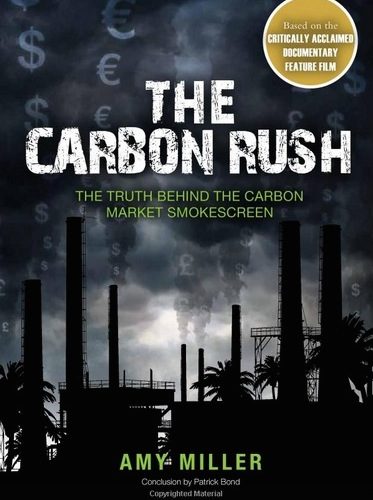The success of Amy Miller’s 2013 documentary The Carbon Rush has propelled the creation of an accompanying book of the same name. Originally planning to create a follow up to her previous Canadian film Myths for Profit by focusing on Canada’s carbon offsets, Miller kept encountering the same questions. “But what’s a carbon offset, and what’s the carbon market?” The need for a documentary providing basic information led to the film version of The Carbon Rush explaining how the current emissions trading market works.
The success of Amy Miller’s 2013 documentary The Carbon Rush has propelled the creation of an accompanying book of the same name. Originally planning to create a follow up to her previous Canadian film Myths for Profit by focusing on Canada’s carbon offsets, Miller kept encountering the same questions. “But what’s a carbon offset, and what’s the carbon market?” The need for a documentary providing basic information led to the film version of The Carbon Rush explaining how the current emissions trading market works. In this system, companies buy and sell carbon credits in order to justify their own emissions. Businesses with low emissions sell their unused capacity to others who can then pollute more. Additionally, companies can invest money in ‘sustainable’ projects to offset their carbon footprint; a refinery in Grangemouth, for example, instead of lowering their emissions will invest in eucalyptus plantations in Brazil. This scheme, created by the UN and adopted by the Kyoto Protocol, allows companies to treat carbon emissions as a commodity instead of a serious pollutant. The book, an updated version of the same narrative, takes a critical look at the destruction and injustices caused by the carbon market.
The Carbon Rush focuses on projects accredited by the Kyoto Protocol’s Clean Development Mechanism (CDM) for carbon credits in developing countries. Miller doesn’t shy away from the colonial overtones of these exchanges. Overwhelmingly it’s companies in developed countries driving projects in less developed countries. The projects may be able to provide numbers that ‘prove’ how they are reducing carbon emissions – but only by ignoring the ecological damage and human rights violations. The CDM’s stated position is that “it isn’t the job of the CDM to screen for social concerns.” Even when those social concerns include: forcing indigenous people off their land, land theft, intimidation and assassination of locals, poisoning of food due to pollution, and corruption and bribery of government officials.
Eerie pictures of industrial projects and disempowered locals feature prominently, stills from the movie that provide a visual context for the issues described throughout the book. They give faces and identities to struggles that may otherwise seem remote. No one is spared responsibility for the horrific decisions outlined: the UN whose proposal has had no success in driving down emissions, the CDM that continually validates projects that are responsible for causing excessive amounts of damage without accomplishing their stated goal of ‘clean’ development, the governments who turn a blind eye to industrial abuses, and finally the companies themselves. Amy Miller firmly believes that it’s important to move away from the standard model of unending consumption in order to begin to address the climate crisis. “Capitalism is the problem so it can’t be the solution. The solution for the climate crisis will require a reinvention, a transformation of the way our societies function.”
The book is a call to action; Miller envisioned it as a “tool to make transformative change.” It’s not just meant to educate but to inspire action to counteract the injustices done in the name of emissions trading. While the links provided in the book and online point to transnational efforts and projects, the chapter on how to stop emissions trading is North American in focus. “People from North America need to take responsibility, ” Miller states, ” It’s ridiculous to have to say that we are the biggest polluters, of course we’re the ones who should take responsibility to bring about change.”
Miller knows it is important to use all the means at our disposal to inform the public and to act against the carbon market. The lack of awareness and resistance is shameful when juxtaposed with ongoing protests throughout the global south against CDM projects and the accompanying destruction. “Who’s doing the resisting?” Miller asks. “Not people here.” But she has hope that her work can change that, fueling the drive to fight for global climate justice.
Why grab the book when you can just watch the documentary? For one, the book contains more recent information. It also provides more in-depth information, specifics that couldn’t be placed in the documentary. Unfortunately the book lacks an index, making it a somewhat impractical reference. Despite the number of pictures it contains a wealth of information that can be difficult to access quickly without an index. For those concerned about the carbon market, however, it is definitely worth the read.
The Carbon Rush, Amy Miller, Markham, Ontario: Red Deer Press, 2014, 180 pages
Reviewer Information
Michelle is a former A\J editorial intern with a graduate diploma in Science Communication from Laurentian University.













